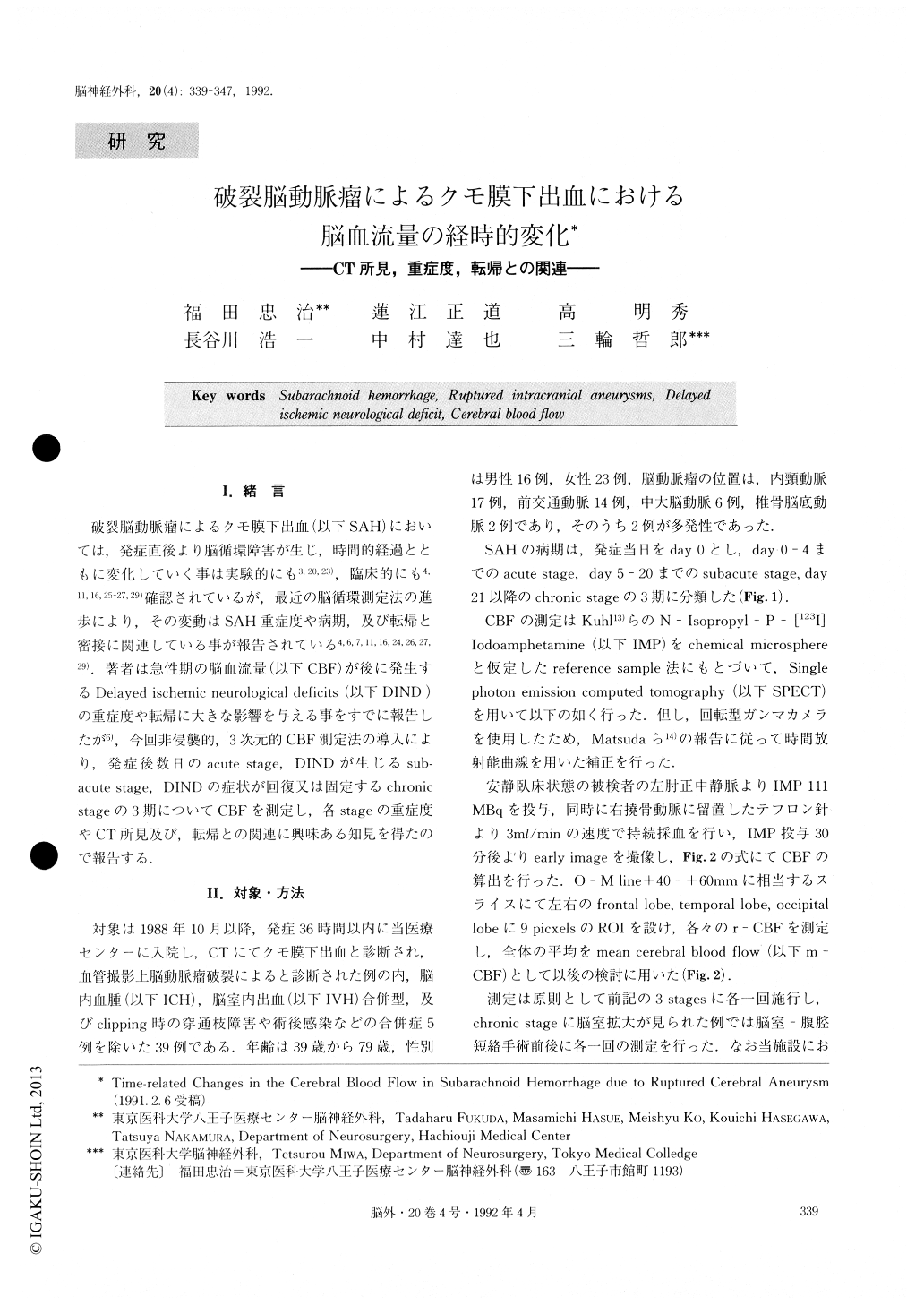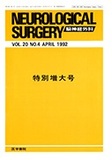Japanese
English
- 有料閲覧
- Abstract 文献概要
- 1ページ目 Look Inside
I.緒言
破裂脳動脈瘤によるクモ膜下出出(以下SAH)においては,発症直後より脳循環障害が生じ,時間的経過とともに変化していく事は実験的にも3,20,23),臨床的にも4,11,16,25-27,39)確認されているが,最近の脳循環測定法の進歩により,その変動はSAH重症度や病期,及び転帰と密接に関連している事が報告されている4,6,7,11,16,24,26,27,29).著者は急性期の脳血流量(以下CBF)が後に発生するDelayed ischemic neurological deficits(以下DIND)の重症度や転帰に大きな影響を与える事をすでに報告したが6),今回非侵襲的,3次元的CBF測定法の導入により,発症後数日のacute stage, DINDが生じるsub—acute stage, DINDの症状が回復又は固定するchronicstageの3期についてCBFを測定し,各stageの重症度やCT所見及び,転帰との関連に興味ある知見を得たので報告する.
Cerebral blood flow (CBF) was determined by the 123I-IMP SPECT reference sample method in 39 pa-tients with subarachnoid hemorrhage (SAH) clue to ruptured cerebral aneurysm. They were examined according to the time lapse after onset, severity, CT findings, and prognosis. These 39 patients were admit-ted to our medical center within 36 hours after the onset, and SAH and ruptured aneurysm were dia-gnosed by CT scan and angiography, respectively. Pa-tients with intraventricular hemorrhage, intracerebral hematoma, and other severe complications were ex-cluded. The stage of SAH was divided into three, by designating the clay of onset as clay 0: clay 0-4 as the acute stage, day 5-20 as the subacute stage, and clay 21 and after that as the chronic stage. Acute stage surgery was conducted within 48 hours after the onset on prin-ciple. Hyperclynamic therapy and cisternal drainage were conducted in severe case of SAH. The prognosis was evaluated with Glasgow outcome scale (GOS). The average CBF was 33.39, 29.44, and 33.15 in the acute, subacute, and chronic stages, respectively. These are values lower than the reference sample value, 43.39 (ml/100g/min) . Only a small number of cases, how-ever, revealed vasospasm by angiography conducted in the acute stage. There was a correlation between the CT severity in the acute stage and the decrease in CBF. In the group with low density area (LDA) on CT clue to delayed cerebral ischemia in the subacute stage, the average CBF was 28.28 and 23.95 in the acute and subacute stages, respectively. These values were signifi-cantly lower than 35.97 and 32.45, respectively, in the group without LDA. CBF decreased by 0.79 in the group with cisternal drainage from the acute stage to the subacute stage, which is smaller than the decrease of 7.15 in the group without drainage. In the cases in which ventricular-peritoneal shunt was conducted for hydrocepharus in the chronic stage, increased CBF was observed after surgery. CBF of the group with good re-covery achieved by GUS was higher both in the acute and subacute stages than that found in the severely dis-abled cases and cases which resulted in death. Prog-nosis was better in the group with acute CBI.' of over 30 than the group with that of less than 30. Time re-lated determination of CBF in SAH was useful for the evaluation of the condition of SAH, selection of the therapeutic methods, and estimation of the prognosis.

Copyright © 1992, Igaku-Shoin Ltd. All rights reserved.


